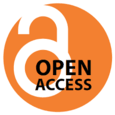In-silico Prediction of Azadirachta indica Compounds as Potential Therapeutic Inhibitor of Lysyl Oxidase to Suppress Canine Mammary Tumor Proliferation
In-silico Prediction of Azadirachta indica Compounds
DOI:
https://doi.org/10.54393/fbt.v3i02.42Keywords:
Mammary Tumor Treatment, Molecular Drug Development, Canis familiaris, Neem PlantAbstract
Canine mammary tumor (CMT) is one of the leading causes of death in female dogs, mainly due to the unavailability/expensive treatment, adverse and untargeted nature of the contemporary therapeutics. Objectives: To discover a biological mediator from the Azadirachta indica extracts by targeting Lysyl Oxidase (LOX), which is one of the enzymes responsible for accelerating the development of tumors and altering cellular microenvironment in mammals is considered to be suitable targets for anti-cancerous drugs.
Methods: Current study utilized computer-aided drug designing (CADD) to investigate 33 phytocompounds derived from this plant to check their potential inhibition properties against LOX protein. The phytochemicals were docked onto the protein and the ligands with the lowest binding energies were evaluated over the several parameters using PyRx software. Molecular dynamic simulation was also performed to further investigate the stability and conformational changes of the resultant ligand-protein complex by analyzing RMSD & RMSF values, H-bond graphs and Heat maps through VMD/NAMD softwares. Results: The results revealed that Azadirachtin to be the most pertinent agent in LOX inhibition with a docking score of -12.6 kcal/mol and showed promising in-silico stability as well. Drug likeliness potential was further assessed based on Lipinski’s rule of five which reflect the safer nature of this drug agent. Conclusions: Moreover, wet-lab in-vitro experiments followed by clinical trials are still needed to attest the validity of this virtually piloted phytocompound against LOX protein for CMT cure.
References
Pugliese M, Falcone A, Alibrandi A, Zirilli A, Passantino AJVS. Risk Factors Regarding Dog Euthanasia and Causes of Death at a Veterinary Teaching Hospital in Italy: Preliminary Results. 2022 Oct; 9(10): 554. doi: 10.3390/vetsci9100554.
Choi JW, Yoon HY, Jeong S-W. Clinical outcomes of surgically managed spontaneous tumors in 114 client-owned dogs. Immune network. 2016 Apr; 16(2): 116-25. doi: 10.4110/in.2016.16.2.116.
Nunes FC, Damasceno KA, de Campos CB, Bertagnolli AC, Lavalle GE, Cassali GD. Mixed tumors of the canine mammary glands: Evaluation of prognostic factors, treatment, and overall survival. Veterinary and Animal Science. 2019 Jun; 7: 100039. doi: 10.1016/j.vas.2018.09.003.
Salas Y, Márquez A, Diaz D, Romero L. Epidemiological study of mammary tumors in female dogs diagnosed during the period 2002-2012: a growing animal health problem. PloS One. 2015 May; 10(5): e0127381. doi: 10.1371/journal.pone.0127381.
Raduly L, Cojocneanu-Petric R, Sarpataki O, Chira S, Atanasov AG, Braicu C, et al. Canis lupus familiaris as relevant animal model for breast cancer-a comparative oncology review. Animal Science Papers & Reports. 2018 Apr; 36(2): 119-48.
Stratmann N, Failing K, Richter A, Wehrend A. Mammary tumor recurrence in bitches after regional mastectomy. Veterinary Surgery. 2008 Jan; 37(1): 82-6. doi: 10.1111/j.1532-950X.2007.00351.x.
Peña L, Andrés PD, Clemente M, Cuesta P, Pérez-Alenza MD. Prognostic value of histological grading in noninflammatory canine mammary carcinomas in a prospective study with two-year follow-up: relationship with clinical and histological characteristics. Veterinary Pathology. 2013 Jan; 50(1): 94-105. doi: 10.1177/0300985812447830.
Valdivia G, Alonso-Diez Á, Pérez-Alenza D, Peña L. From conventional to precision therapy in canine mammary cancer: a comprehensive review. Frontiers in Veterinary Science. 2021 Feb; 8: 623800. doi: 10.3389/fvets.2021.623800.
Gray M, Meehan J, Martínez-Pérez C, Kay C, Turnbull AK, Morrison LR, et al. Naturally-occurring canine mammary tumors as a translational model for human breast cancer. Frontiers in Oncology. 2020 Apr; 10: 617. doi: 10.3389/fonc.2020.00617.
Pandey M, Sunil Kumar BV, Gupta K, Sethi RS, Kumar A, Verma R. Over-expression of mammaglobin-B in canine mammary tumors. BMC Veterinary Research. 2018 Dec; 14: 1-8. doi: 10.1186/s12917-018-1507-z.
Al Joudi FS. Human mammaglobin in breast cancer: a brief review of its clinical utility. The Indian Journal of Medical Research. 2014 May; 139(5): 675.
Saleem A, Singh S, Sunil Kumar BV, Arora JS, Choudhary RK. Analysis of lysyl oxidase as a marker for diagnosis of canine mammary tumors. Molecular Biology Reports. 2019 Oct; 46: 4909-19. doi: 10.1007/s11033-019-04941-1.
Terajima M, Taga Y, Brisson BK, Durham AC, Sato K, Uzawa K, et al. Collagen molecular phenotypic switch between non-neoplastic and neoplastic canine mammary tissues. Scientific Reports. 2021 Apr; 11(1): 8659. doi: 10.1038/s41598-021-87380-y.
Xiao Q and Ge G. Lysyl oxidase, extracellular matrix remodeling and cancer metastasis. Cancer Microenvironment. 2012 Dec; 5: 261-73. doi: 10.1007/s12307-012-0105-z.
Alzohairy MA. Therapeutics role of Azadirachta indica (Neem) and their active constituents in diseases prevention and treatment. Evidence-Based Complementary and Alternative Medicine. 2016 Oct; 2016: 7382506. doi: 10.1155/2016/7382506.
Rahmani A, Almatroudi A, Alrumaihi F, Khan A. Pharmacological and therapeutic potential of neem (Azadirachta indica). Pharmacognosy Reviews. 2018 Feb; 12(24): 250-5. doi: 10.4103/phrev.phrev_8_18.
Nasim N, Sandeep IS, Mohanty S. Plant-derived natural products for drug discovery: Current approaches and prospects. The Nucleus. 2022 Dec; 65(3): 399-411. doi: 10.1007/s13237-022-00405-3.
Rai V, Aggarwal SK, Verma SS, Awasthee N, Dhasmana A, Aggarwal S, et al. Epoxyazadiradione exhibit activities in head and neck squamous cell carcinoma by targeting multiple pathways. Apoptosis. 2020 Oct; 25: 763-82. doi: 10.1007/s10495-020-01633-1.
Malar TJ, Antonyswamy J, Vijayaraghavan P, Kim YO, Al-Ghamdi AA, Elshikh MS, et al. In-vitro phytochemical and pharmacological bio-efficacy studies on Azadirachta indica A. Juss and Melia azedarach Linn for anticancer activity. Saudi Journal of Biological Sciences. 2020 Feb; 27(2): 682-8. doi: 10.1016/j.sjbs.2019.11.024.
Greenwell M and Rahman PK. Medicinal plants: their use in anticancer treatment. International Journal of Pharmaceutical Sciences and Research. 2015 Oct; 6(10): 4103. doi: 10.1016/S1570-9639(03)00147-X.
Passariello C, Schippa S, Iori P, Berlutti F, Thaller MC, Rossolini GM. The molecular class C acid phosphatase of Chryseobacterium meningosepticum (OlpA) is a broad-spectrum nucleotidase with preferential activity on 5′-nucleotides. Biochimica et Biophysica Acta (BBA)-Proteins and Proteomics. 2003 May; 1648(1-2): 203-9. doi: 10.1016/S1570-9639(03)00147-X.
Johnston KA and Lopez KM. Lysyl oxidase in cancer inhibition and metastasis. Cancer Letters. 2018 Mar; 417: 174-81. doi: 10.1016/j.canlet.2018.01.006.
Yang J and Zhang Y. I-TASSER server: new development for protein structure and function predictions. Nucleic Acids Research. 2015 Jul; 43(W1): W174-81. doi: 10.1093/nar/gkv342.
Lipinski CA. Lead-and drug-like compounds: the rule-of-five revolution. Drug Discovery Today: Technologies. 2004 Dec; 1(4): 337-41. doi: 10.1016/j.ddtec.2004.11.007.
Benet LZ, Hosey CM, Ursu O, Oprea TI. BDDCS, the Rule of 5 and drugability. Advanced Drug Delivery Reviews. 2016 Jun; 101: 89-98. doi: 10.1016/j.addr.2016.05.007.
Maurya VK, Kumar S, Prasad AK, Bhatt ML, Saxena SK. Structure-based drug designing for potential antiviral activity of selected natural products from Ayurveda against SARS-CoV-2 spike glycoprotein and its cellular receptor. Virusdisease. 2020 Jun; 31: 179-93. doi: 10.1007/s13337-020-00598-8.
Rudrapal M, Issahaku AR, Agoni C, Bendale AR, Nagar A, Soliman ME, et al. In silico screening of phytopolyphenolics for the identification of bioactive compounds as novel protease inhibitors effective against SARS-CoV-2. Journal of Biomolecular Structure and Dynamics. 2022 Nov; 40(20): 10437-53. doi: 10.1080/07391102.2021.1944909.
Yang L, Song G, Jernigan RL. How well can we understand large-scale protein motions using normal modes of elastic network models? Biophysical Journal. 2007 Aug; 93(3): 920-9. doi: 10.1529/biophysj.106.095927.
Martínez L. Automatic identification of mobile and rigid substructures in molecular dynamics simulations and fractional structural fluctuation analysis. PloS One. 2015 Mar; 10(3): e0119264. doi: 10.1371/journal.pone.0119264.
Wade RC and Goodford PJ. The role of hydrogen-bonds in drug binding. Progress in Clinical and Biological Research. 1989 Jan; 289: 433-44.
Moo TA and Sanford R, Dang C, Morrow M. Overview of breast cancer therapy. PET Clinics. 2018 Jul; 13(3): 339-54. doi: 10.1016/j.cpet.2018.02.006.
Zhang XF, Liu ZG, Shen W, Gurunathan S. Silver nanoparticles: synthesis, characterization, properties, applications, and therapeutic approaches. International Journal of Molecular Sciences. 2016 Sep; 17(9): 1534. doi: 10.3390/ijms17091534.
Poompavai S, Gowri Sree V, RamSugitha B. Enhanced Extraction and Improved Anticancer Activity of Neem (Azadirachta indica) Leaves by Electroporation Technique. IETE Journal of Research. 2021 Aug; 69(8): 4961-71. doi: 10.1080/03772063.2021.1962743.
Iman M, Taheri M, Bahari Z. The anti-cancer properties of neem (Azadirachta indica) through its antioxidant activity in the liver: its pharmaceutics and toxic dosage forms. A literature review. Journal of Complementary and Integrative Medicine. 2021 May; 19(2): 203-11. doi: 10.1515/jcim-2021-0009.
Burguin A, Diorio C, Durocher F. Breast cancer treatments: updates and new challenges. Journal of Personalized Medicine. 2021 Aug; 11(8): 808. doi: 10.3390/jpm11080808.
Downloads
Published
How to Cite
Issue
Section
License
Copyright (c) 2023 Futuristic Biotechnology

This work is licensed under a Creative Commons Attribution 4.0 International License.
This is an open-access journal and all the published articles / items are distributed under the terms of the Creative Commons Attribution License, which permits unrestricted use, distribution, and reproduction in any medium, provided the original author and source are credited. For comments editor@fbtjournal.com











